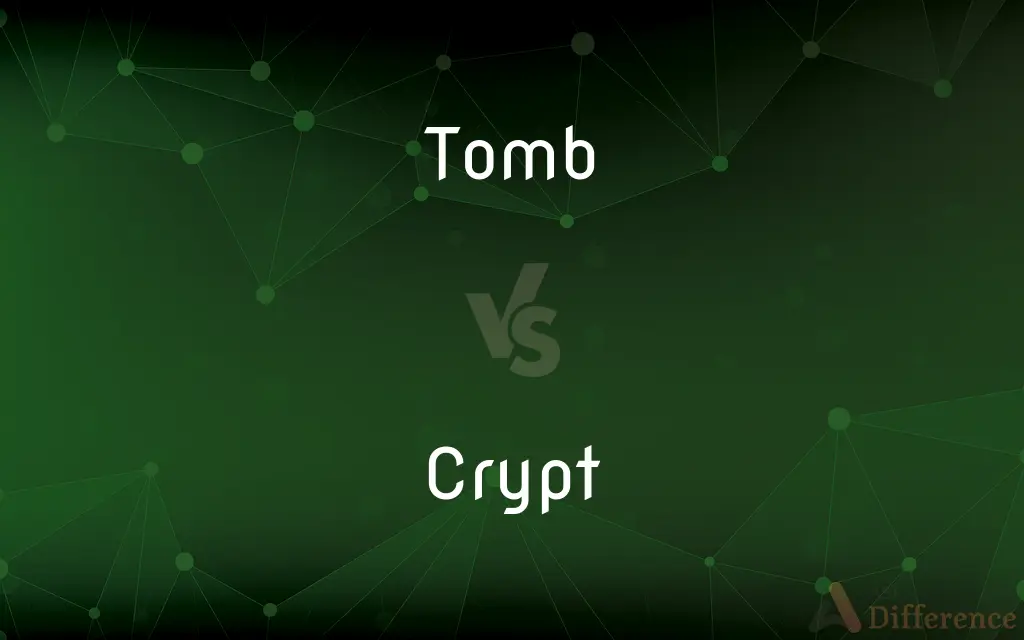Tomb vs. Crypt — What's the Difference?
Edited by Tayyaba Rehman — By Urooj Arif — Updated on April 6, 2024
A tomb is a structure for housing after gone, while a crypt is an underground room beneath a church or cemetery used for burial.

Difference Between Tomb and Crypt
Table of Contents
ADVERTISEMENT
Key Differences
A tomb is a standalone structure or chamber designed to house the remains of the deceased. Crypts, in contrast, are specifically underground burial spaces, typically found beneath churches or chapels.
While both tombs and crypts serve as final resting places, their location and association differ significantly. Tombs may be found in various settings, including dedicated cemeteries, within church grounds, or in isolated spots chosen for their significance to the deceased or their family. Crypts, however, are always part of a larger religious structure and are often situated directly beneath the place of worship, making them a more integral part of the religious and communal life of the congregation.
Tombs are usually constructed with the intent to memorialize or pay tribute to the deceased, often reflecting the personal, familial, or cultural significance of the individual(s) buried within. Crypts, on the other hand, while also serving as memorials, have a closer connection to religious practices and traditions. They may house relics or the remains of individuals considered to be of particular spiritual significance, such as saints or martyrs.
The primary distinction between the two lies in their design and cultural associations. A tomb is more versatile in its form and can be an expression of individual or collective identity, while a crypt is defined by its religious context and underground location, serving as a sacred space for remembrance within the framework of religious tradition.
Comparison Chart
Location
Can be above or partially below ground, in various environments.
Always underground, typically beneath churches or chapels.
ADVERTISEMENT
Association
With individuals, families, or cultural practices.
With religious buildings and practices.
Purpose
To house the remains of the deceased, with a focus on memorialization.
To serve as a burial place within a religious context.
Design
Varied, reflecting the status or beliefs of the deceased.
Often simpler, focused on spiritual significance rather than ostentation.
Cultural Significance
Reflects personal, familial, or cultural significance.
Emphasizes a connection to the religious community and practices.
Compare with Definitions
Tomb
May accommodate individuals or groups.
The communal tomb held the remains of the village elders.
Crypt
Integrates burial within the context of worship.
The ancient church's crypt contained relics of early martyrs.
Tomb
A structure built to commemorate the after life.
The family visited the ancestral tomb to pay their respects.
Crypt
A part of a religious building, associated with sacred practices.
The crypt was opened for a special ceremony to honor the patron saint.
Tomb
Can be found in cemeteries or isolated locations.
The knight's tomb was located on a hill overlooking the village.
Crypt
An underground room beneath a church used for burials.
The saints were interred in the crypt below the cathedral.
Tomb
Reflects social status or beliefs.
The ornate tomb stood as a testament to the merchant's wealth and piety.
Crypt
Serves as a place of reflection and connection for the faithful.
Visitors to the crypt lit candles in memory of the departed.
Tomb
A grave or other place of burial.
Crypt
Houses the remains of religious figures or dignitaries.
The bishop's crypt was located directly beneath the altar.
Tomb
One who keeps secrets.
Crypt
A crypt (from Latin crypta "vault") is a stone chamber beneath the floor of a church or other building. It typically contains coffins, sarcophagi, or religious relics.
Tomb
(transitive) To bury.
Crypt
An underground vault or chamber, especially one beneath a church that is used as a burial place.
Tomb
To place in a tomb; to bury; to inter; to entomb.
I tombed my brother that I might be blessed.
Crypt
(Anatomy) A small pit, recess, or glandular cavity in the body.
Tomb
A place for the burial of a corpse (especially beneath the ground and marked by a tombstone);
He put flowers on his mother's grave
Crypt
A cave or cavern.
Crypt
An underground vault, especially one beneath a church that is used as a burial place.
Crypt
(anatomy) A small pit or cavity in the surface of an organ or other structure.
Crypt
(botany) Any of the genus Cryptocoryne of aquatic plants of southern and southeastern Asia.
Crypt
(botany) Any of the genus Cryptopus of orchids of Madagascar and Mauritius.
Crypt
A vault wholly or partly under ground; especially, a vault under a church, whether used for burial purposes or for a subterranean chapel or oratory.
Priesthood works out its task age after age, . . . treasuring in convents and crypts the few fossils of antique learning.
My knees are bowed in crypt and shrine.
Crypt
A simple gland, glandular cavity, or tube; a follicle; as, the crypts of Lieberkühn, the simple tubular glands of the small intestines.
Crypt
A cellar or vault or underground burial chamber (especially beneath a church)
Common Curiosities
What is the significance of crypts in religious practices?
Crypts symbolize the spiritual connection between the living and the deceased, serving as sacred spaces for reflection and veneration within the religious community.
What is the purpose of a tomb?
To serve as a final resting place and memorial for the deceased.
Can anyone be buried in a crypt?
Typically, crypts are reserved for religious figures, saints, or individuals of particular significance to the church community.
Can crypts be visited by the public?
Depending on the church's policy, crypts may be open to the public for visitation, reflection, and prayer.
How is a crypt different from a tomb?
A crypt is specifically an underground burial space beneath a church, while a tomb can be located in various settings and structures.
What role do crypts play in church architecture?
Crypts are an integral part of church architecture, providing a sacred space for burial and veneration beneath the worship space.
Are tombs only for the wealthy or noble?
Historically, elaborate tombs were often built for the wealthy or noble, but tombs can range widely in style and scale, reflecting various cultural practices.
Can a tomb be part of a church?
Yes, tombs can be located within church grounds or even within the church itself, though they are not typically underground like crypts.
Is the design of a tomb important?
Yes, the design of a tomb can reflect the deceased's status, beliefs, and cultural identity, serving as a lasting tribute.
How are tombs and crypts preserved?
Preservation efforts vary but often involve restoration work and maintenance to ensure their structural integrity and historical significance are maintained.
Share Your Discovery

Previous Comparison
Suppose vs. Suspect
Next Comparison
Deck vs. SlabAuthor Spotlight
Written by
Urooj ArifUrooj is a skilled content writer at Ask Difference, known for her exceptional ability to simplify complex topics into engaging and informative content. With a passion for research and a flair for clear, concise writing, she consistently delivers articles that resonate with our diverse audience.
Edited by
Tayyaba RehmanTayyaba Rehman is a distinguished writer, currently serving as a primary contributor to askdifference.com. As a researcher in semantics and etymology, Tayyaba's passion for the complexity of languages and their distinctions has found a perfect home on the platform. Tayyaba delves into the intricacies of language, distinguishing between commonly confused words and phrases, thereby providing clarity for readers worldwide.














































